List of events
| |||||
| Decades: | |||||
|---|---|---|---|---|---|
| See also: | |||||
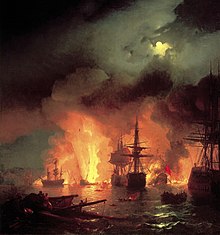
Events in the year 1770 in Russia
| |||||
| Decades: | |||||
|---|---|---|---|---|---|
| See also: | |||||
| History of Russia |
|---|
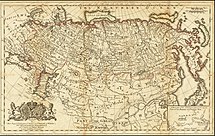 |

Events in the year 1770 in Russia
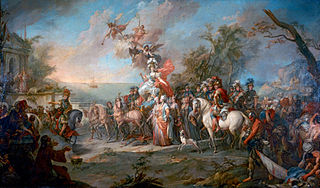
The Russo-Turkish War of 1768–1774 was a major armed conflict that saw Russian arms largely victorious against the Ottoman Empire. Russia's victory brought the Yedisan between the rivers Bug and Dnieper, and Crimea into the Russian sphere of influence. Through a series of victories accrued by the Russian Empire led to substantial territorial conquests, including direct conquest over much of the Pontic–Caspian steppe, less Ottoman territory was directly annexed than might otherwise be expected due to a complex struggle within the European diplomatic system to maintain a balance of power that was acceptable to other European states and avoided direct Russian hegemony over Eastern Europe.

The Orlov revolt was a Greek uprising in the Peloponnese and later also in Crete that broke out in February 1770, following the arrival of Russian Admiral Alexey Orlov, commander of the Imperial Russian Navy during the Russo-Turkish War (1768–1774), at the Mani Peninsula. The revolt, a major precursor to the Greek War of Independence, was part of Catherine the Great's so-called "Greek Plan" and was eventually suppressed by the Ottomans.

The Russo-Turkish War (1806–1812) between the Russian Empire and the Ottoman Empire was one of the Russo-Turkish Wars. Russia prevailed, but both sides wanted peace as they feared Napoleon's moves to the east.

The Battle of Athos took place on 1–2 July 1807New Style as a part of the Napoleonic Wars during the Russo-Turkish War of 1806–1812.

The Battle of Sinop, or the Battle of Sinope, was a naval battle that took place on 30 November 1853 between Imperial Russia and the Ottoman Empire, during the opening phase of the Crimean War (1853–1856). It took place at Sinop, a sea port on the southern shore of the Black Sea. A Russian squadron attacked and decisively defeated an Ottoman squadron anchored in Sinop's harbor. The Russian force consisted of six ships of the line, two frigates and three armed steamers, led by Admiral Pavel Nakhimov; the Ottoman defenders were seven frigates, three corvettes and two armed steamers, commanded by Vice Admiral Osman Pasha.

The Russo-Turkish War of 1735–1739 between Russia and the Ottoman Empire was caused by the Ottoman Empire's war with Persia and continuing raids by the Crimean Tatars. The war also represented Russia's continuing struggle for access to the Black Sea. In 1737, the Habsburg monarchy joined the war on Russia's side, known in historiography as the Austro-Turkish War of 1737–1739.

The naval battle of Cheshme took place on 5–7 July 1770 during the Russo-Turkish War (1768–1774) near and in Çeşme Bay, in the area between the western tip of Anatolia and the island of Chios, which was the site of a number of past naval battles between the Ottoman Empire and the Republic of Venice. It was a part of the Orlov Revolt of 1770, a precursor to the later Greek War of Independence (1821–1829), and the first of a number of disastrous fleet battles for the Ottomans against Russia. Today it is commemorated as a Day of Military Honour in Russia.
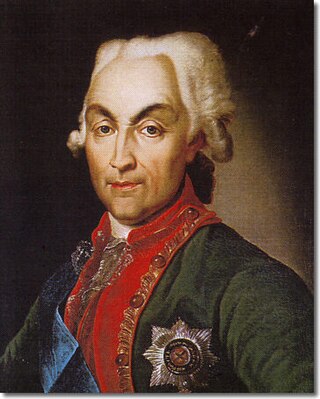
Prince Nikolai (Nicholas) Vasilyevich Repnin was an Imperial Russian statesman and general from the Repnin princely family who played a key role in the dissolution of the Polish–Lithuanian Commonwealth.

Cezayirli Gazi Hasan Pasha or Hasan Pasha of Algiers was an Ottoman Grand Admiral (1770–90), Grand Vizier (1790), and general in the late 18th century.
Russo-Turkish wars or Russo-Ottoman wars were a series of twelve wars fought between the Russian Empire and the Ottoman Empire between the 16th and 20th centuries. It was one of the longest series of military conflicts in European history. Except for the war of 1710–11, as well as the Crimean War which is often treated as a separate event, the conflicts ended disastrously for the Ottoman Empire; conversely, they showcased the ascendancy of Russia as a European power after the modernization efforts of Peter the Great in the early 18th century.

Count Pyotr Alexandrovich Rumyantsev-Zadunaisky was one of the foremost Russian generals of the 18th century, and one of the great military commanders in universal history between 1618 and 1905. Rumyantsev used mobile divisional squares for the first time in history as opposed to linear battle orders and initiated the formation of light (jaeger) battalions in the Russian Army, which operated in a scattered order.

Çeşme is a municipality and district of İzmir Province, Turkey. Its area is 285 km2, and its population is 48,924 (2022). It sits at Turkey's westernmost end, on a promontory on the tip of the peninsula that also carries the same name and that extends inland to form a whole with the wider Urla-Karaburun-Çeşme Peninsula. It is a popular holiday resort and the district center, where two thirds of the district population is concentrated. Çeşme is located 85 km west of İzmir, the largest metropolitan center in Turkey's Aegean Region. There is a six-lane highway connecting the two cities. Çeşme district has two neighboring districts, Karaburun to the north and Urla to the east, both of which are also part of İzmir Province. The name "Çeşme" means "fountain" and possibly draws reference from the many Ottoman fountains that are scattered across the city.

The Battle of Larga was fought between 65,000 Crimean Tatars cavalry and 15,000 Ottoman infantry under Qaplan II Giray against 38,000 Russians under Field-Marshal Rumyantsev on the banks of the Larga River, a tributary of the Prut River, in Moldavia, for eight hours on 7 July 1770. It was fought on the same day as Battle of Chesma, a key naval engagement of the Russo-Turkish War, 1768–1774.

The Battle of Kagul or Cahul occurred on 1 August 1770 during the Russo-Turkish War of 1768–1774. It was the decisive and most important land battle of the war and one of the largest battles of the 18th century. It was fought in Moldavia, near the village of Frumoasa, nearly a month after the Russian victory at Larga.
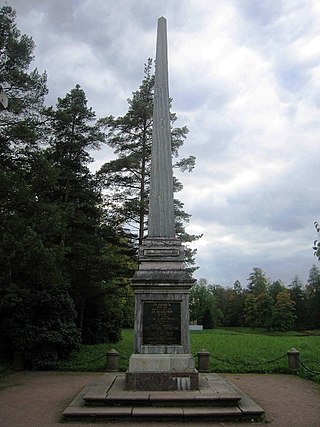
The Kagul Obelisk in Tsarskoye Selo is one of several such structures erected on behest of Catherine II of Russia in 1772 to commemorate Pyotr Rumyantsev's victory in the Battle of Kagul. Designed by Antonio Rinaldi, the dark grey-and-red marble obelisk stands in the landscape park of the Catherine Palace.

The Battle of Rymnik or Rimnik on September 22 (11), 1789, took place in Wallachia, at the Râmnicul Sărat River near Râmnicu Sărat, during the Russo-Turkish War of 1787–1792. The Russian general Alexander Suvorov, acting together with the Habsburg general Prince Josias of Coburg, attacked the main Ottoman army under Grand Vizier Cenaze Hasan Pasha. The result was a crushing Russo-Austrian victory.

The Ottoman Navy or The Imperial Navy, also known as the Ottoman Fleet, was the naval warfare arm of the Ottoman Empire. It was established after the Ottomans first reached the sea in 1323 by capturing Praenetos, the site of the first Ottoman naval shipyard and the nucleus of the future navy.
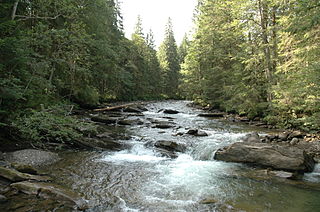
The Prut is a 953 km (592 mi) long river in Eastern Europe. It is a left tributary of the Danube. In part of its course it forms Romania's border with Moldova and Ukraine.
Mandalzade Husamaddin Pasha was an Ottoman statesman and admiral. In 1770 he was decorated as commander of the Ottoman navy.
The Mediterranean Fleet was a short-lived fleet of the Imperial Russian Navy in the Mediterranean Sea, active during the Russo-Turkish War of 1768–1774.